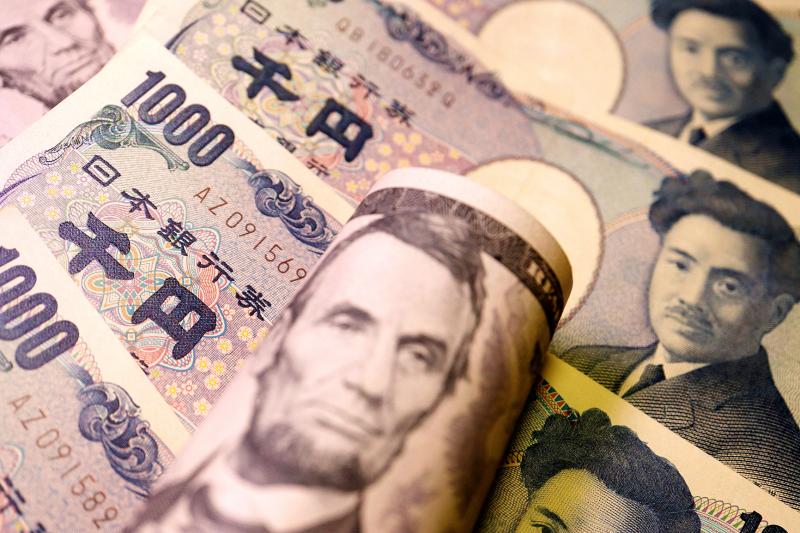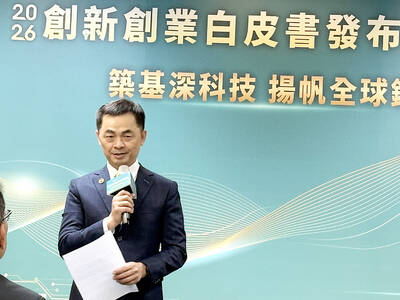The Japanese yen fell against the US dollar on Friday, after the Bank of Japan bucked a wave of tightening and stuck with its ultra-accommodative stance, adding to soaring volatility in a currency markets hit by a series of rate hikes this week.
Currency markets have been roiled by one of the biggest runs of monetary policy tightening in decades, including the US Federal Reserve’s mid-week 0.75 percent rate increase, its biggest since 1995, and the Swiss National Bank’s surprise decision to hike rates by 0.5 percent.
The Bank of Japan (BOJ) went against the current on Friday, keeping all of its policy settings unchanged and vowing to defend its bond yield cap of 0.25 percent with unlimited buying.

Photo: Reuters
The BOJ’s move knocked the yen, which on Wednesday hit a 24-year low of ¥135.6 per US dollar, broadly lower. It closed down 2.11 percent against the greenback at ¥134.96.
“Today we’re seeing a rebalancing of the market. It’s been a very volatile week,” said Simon Harvey, head of FX analysis at Monex Europe. “Markets are still adjusting to the central bank meetings from throughout the week.”
The US dollar rose off a one-week low against major peers, following a two-day slide after the Fed’s mid-week rate increase of 0.75 percent, a move that was anticipated by markets as the Fed attempts to tame stubbornly high inflation.
The US dollar index, which measures the currency against a basket of six rivals, was up 0.98 percent at 104.65, posting a weekly increase of 0.48 percent.
US Treasury yields held at lower levels on Friday after a volatile week that saw yields hit more than 10-year highs on expectations of aggressive rate hikes, and then fall on concerns about how they would affect growth.
The New Taiwan dollar rose against the greenback on Friday, gaining NT$0.015 to close at NT$29.720, but losing 0.46 percent over the week.
The Swiss National Bank’s (SNB) surprise decision to raise rates by 0.5 percent continued to reverberate through markets.
The euro closed down 0.5 percent at US$1.0497 versus the US dollar.
The franc rocketed to a two-month high on Thursday after the rate hike and boosted by a sense among investors that the SNB would not try and stop a strengthening franc as it has in the past.
Giving up earlier gains on Friday, the US dollar lost 0.39 percent to 0.9702 francs, after tumbling the most in seven years overnight.
“The surprise rate hike in Switzerland, as well as the European Central Bank’s announcement that it is working on a tool to prevent the fragmentation of the European bond markets, will help to limit USD strength around current levels,” strategists at UBS’ Global Wealth Management’s Chief Investment Office said in a research note.
Sterling dropped 1.03 percent to US$1.2223, giving back nearly all of its overnight gains from when the Bank of England decided to lift rates again, albeit by less than many in the market had expected, along with a hawkish signal about future policy action.
Additional reporting by CNA, with staff writer

CHIP RACE: Three years of overbroad export controls drove foreign competitors to pursue their own AI chips, and ‘cost US taxpayers billions of dollars,’ Nvidia said China has figured out the US strategy for allowing it to buy Nvidia Corp’s H200s and is rejecting the artificial intelligence (AI) chip in favor of domestically developed semiconductors, White House AI adviser David Sacks said, citing news reports. US President Donald Trump on Monday said that he would allow shipments of Nvidia’s H200 chips to China, part of an administration effort backed by Sacks to challenge Chinese tech champions such as Huawei Technologies Co (華為) by bringing US competition to their home market. On Friday, Sacks signaled that he was uncertain about whether that approach would work. “They’re rejecting our chips,” Sacks

NATIONAL SECURITY: Intel’s testing of ACM tools despite US government control ‘highlights egregious gaps in US technology protection policies,’ a former official said Chipmaker Intel Corp has tested chipmaking tools this year from a toolmaker with deep roots in China and two overseas units that were targeted by US sanctions, according to two sources with direct knowledge of the matter. Intel, which fended off calls for its CEO’s resignation from US President Donald Trump in August over his alleged ties to China, got the tools from ACM Research Inc, a Fremont, California-based producer of chipmaking equipment. Two of ACM’s units, based in Shanghai and South Korea, were among a number of firms barred last year from receiving US technology over claims they have

BARRIERS: Gudeng’s chairman said it was unlikely that the US could replicate Taiwan’s science parks in Arizona, given its strict immigration policies and cultural differences Gudeng Precision Industrial Co (家登), which supplies wafer pods to the world’s major semiconductor firms, yesterday said it is in no rush to set up production in the US due to high costs. The company supplies its customers through a warehouse in Arizona jointly operated by TSS Holdings Ltd (德鑫控股), a joint holding of Gudeng and 17 Taiwanese firms in the semiconductor supply chain, including specialty plastic compounds producer Nytex Composites Co (耐特) and automated material handling system supplier Symtek Automation Asia Co (迅得). While the company has long been exploring the feasibility of setting up production in the US to address

OPTION: Uber said it could provide higher pay for batch trips, if incentives for batching is not removed entirely, as the latter would force it to pass on the costs to consumers Uber Technologies Inc yesterday warned that proposed restrictions on batching orders and minimum wages could prompt a NT$20 delivery fee increase in Taiwan, as lower efficiency would drive up costs. Uber CEO Dara Khosrowshahi made the remarks yesterday during his visit to Taiwan. He is on a multileg trip to the region, which includes stops in South Korea and Japan. His visit coincided the release last month of the Ministry of Labor’s draft bill on the delivery sector, which aims to safeguard delivery workers’ rights and improve their welfare. The ministry set the minimum pay for local food delivery drivers at